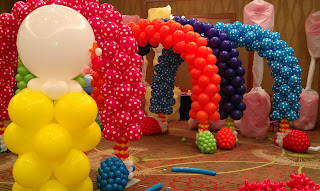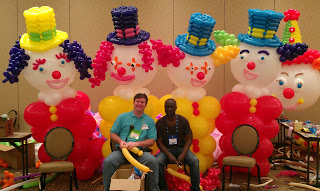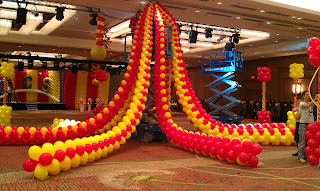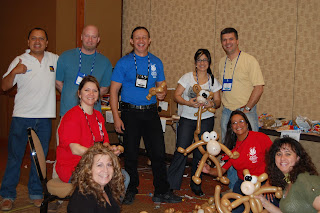Friday, October 24, 2014
Part 6 Beginners Guide to the Elements and Principles of Design - Unity & Harmony
Friday, March 26, 2021
The Importance of Principles and Elements of Design in Balloon Art!
Earlier this week, I was given the honour of taking part in the Q Corner Convention as part of the Design Panel discussion group alongside Tope Abulude, Cam Woody and Aleks and Nelly Hernández.
The first question we were asked as a group was "Which of the Principles and Elements of Design is the most important to a creation and why?"
This got me to thinking... how many balloon artists actually consider the basic principles and elements of design when making their decor? Is this something that many of us naturally do, or should it be considered more frequently?
So, let me put this to you in a different way - have you ever made a design or decor that does not look right, and while you know something is not quite right, you can't quite put your finger on it? Knowing the basics can prevent this from happening!
So what are the Principles and Elements of Design?Creating the 'perfect' design is not something that just happens, at least not for most of us anyway! There are a number of factors that can help to make a design 'perfect,' so let's take a look at what those factors are!
Principles of Design: The basic principles of design include words such as unity, proportion and scale, balance, rhythm and harmony.
By applying the principles to the elements of design, it will bring them together into one design. How you apply these principles determines how successful a design may be!
Principles of Design
Elements of Design
Monday, October 24, 2016
Tips and Tricks of the Trade - Part 2
Learning how to do things easily or in a better way can take many years of trial and error. I know this well as I have been learning for the past 26 years! "Tips and Tricks of the Trade" is a series of posts that will help you with a variety of different techniques that will make life easier and your work look better.
In Part 1 of this series, Chris Adamo, CBA, of Balloons Online, in Sydney, NSW, Australia, shared some fabulous techniques for filling latex balloons with confetti and also how to easily apply vinyl to foil and Bubble Balloons. To view this post, click HERE.
One of my favourite tricks is to cover a base board* using the same Microfoil® balloon that I am featuring in a design.
How to cover a base board.
Here are two designs I made that use a covered base as part of the design. The covered base helps to create visual balance, good proportion, and perfect unity.
Tuesday, October 7, 2014
Part 5. Beginners Guide to the Elements & Principles of Design - Proportion and Scale
Here is a scenario - " I have been asked to create table arrangements for a party in a venue that I have never visited".
- How big are the tables that the designs are being used on?
- What is the size and height of the room?
Monday, June 26, 2017
A Few Tips When Designing And Making Centrepieces.
 |
| Beautiful bat mitzvah centrepiece design by Tanya Joselowsky, CBA, of The Pop, and working with Gideon's Functions and Flowers, Johannesburg, South Africa. |
 |
| Design by Cam Woody, CBA, Pioneer® Balloon Company |
By definition, a centrepiece is a display that can be placed in the centre of a dining table. It helps to set the theme of the event and brings extra decoration to a room.
- Will be the centre of attention at the dinner table— guests have no choice but to spend most of the event gazing at the centrepieces!
- Creates a visual atmosphere that sets the mood for the event
- Ties together the theme of the event and helps bring it to life
- Acts as icebreakers for guests at events with assigned seating
- Provides an opportunity for individual expression
- Can be souvenirs for guests
Leaves a lasting impression—good, or otherwise!
 |
| Tina Giunta, CBA, of Shivoo Balloons in Melbourne, Victoria, Australia, creates two fabulous complimentary centrepiece designs that work perfectly on this rectangular table. |
Mixing Tall and Low Centrepieces - and those all important height rules.
There’s nothing worse than walking into a reception space that feels empty or under-decorated. Mixing short and tall centrepieces will help make a space feel vibrant and full.For tall centrepieces, the added height helps to fill up a room. Just be careful to use them appropriately—you don’t want to block the line of sight for guests. You can put tall centrepieces on tables with less traffic (i.e., gift or buffet tables), or make sure guests can see through the centre of the design. Conversely, short centerpieces are great for accommodating conversation amongst the guests. You’ll want to make sure the centrepieces are low enough that seated guests can see over the top. As a general guideline, you’ll want to start your tall elements 24” (60.96 cm) from the table or higher, and 14" (35.56 cm) or lower is the maximum height for your short elements (the floral industry recommends a 12" height rule for a low centrepiece). When adding helium filled balloons to a centrepiece, ribbon is not considered a visual barrier; be sure to follow the 24" rule. Equally, when using products such as the Lomey Pedestal System or Plexipole, these also do not affect the visual line rule due to the fact that they are made from a clear perspex.
 |
| Centrepiece using the Lomey System |
When designing centrepieces, you need to consider the shape of the tables at the venue. The most common shapes you’ll come across are round, square, and rectangular. Each shape will have its own considerations:
Square: Square tables have more space in the centre than other shapes. Design a more substantial arrangement to utilise this space and keep the table from looking empty.
Rectangular: A single centrepiece on a rectangular table will look lonely. Aim for multiple centrepieces (i.e., a larger middle centrepiece with smaller arrangements on each end). Keep them narrow to avoid crowding the table since you need to leave space for the place settings.
And remember that your centrepiece arrangement should be proportional to the size of the table.
The Design
To find out more about Unity and Harmony, check out my post - Part 6 Beginners Guide to the Elements and Principles of Design - Unity & Harmony
Fantasy Flower
centrepiece design
by Sue Bowler, CBA.
If you would like to know more about Fantasy Flowers, check out my post - The Art of Fantasy Flowers.
I hope that some of you find this post helpful. I love to design and create centrepieces using different techniques and textures within my designs. I would like to thank the very talented Tanya Joselowsky, Tina Giunta, and Cam Woody for allowing me to share their beautiful centrepiece designs with the Very Best Balloon Blog!
Happy Ballooning!
Sue
www.suebowler.com
Wednesday, January 20, 2021
How Can I Find Training Courses as someone who is new to the Balloon Industry?
If you were to ask any seasoned professional what they would do differently if they started their balloon business again, you would find that most of them would have taken up training sooner. Balloon artistry is a creative skill, and there is so much more to it than you many think... but maybe you have already started to find that out?
 |
| Training Instructor TY Wong of Colour Life, Hong Kong |
I know of a number of very successful balloon businesses who started their ballooning journeys in recent years offering only organic décor. They in their own words were 'self-taught'; however, as their businesses grew, so did their clients requests and it became evident that they needed to learn the true foundations of balloon artistry: Classic Balloon Decor.
 |
| Rainbow Arch and Decor by Sue Bowler |
 |
| Decor by Sue Bowler |
Creating the 'perfect' design is not something that just happens automatically, at least not for most of us anyway! There are a number of factors that make a 'perfect design', so let's take a look at what those factors are!
Elements of Design:
These are parts that make up the design, and you can either touch or see the elements of design. These include colour, line, shape and texture.
Principles of Design:
The basic principles of design include unity, scale and proportion, balance, rhythm and harmony.
Applying these principles to the elements of a design brings them together into one cohesive idea. How you apply these principles determines how successful a design may be!
So you may be wondering ,how can you learn about these and where can you find training courses, especially during the pandemic?
It is true to say that the pandemic has definitely thrown a spanner into the works when it comes to face-to-face training courses! However, finding good training in many countries has always been difficult even during normal times.
During the past few months, when many countries have been in lockdown, Qualatex has worked hard to bring training to the world-wide community in the form of webinars. To-date, there has been 10 webinars covering a wide variety of topics.
For anyone new to the balloon business, I would like to recommend:
"Cooking with Cam & Eve - Ingredients for Success Part 1 - Qualatex Latex" as well as "Cooking with Cam & Eve - Ingredients for Success Part 2 - Qualatex Microfoil and Bubble Balloons."
I can even offer you a coupon code that will give you $5.00 off each of these courses!
GoMrQ
If you would like to learn more about the elements and principles of design, and how it will help you with your balloon designs, I have written a number of blog posts that will help you greatly:
Part 4: Beginners Guide to the Elements & Principles of Design - Rhythm
Thursday, January 23, 2020
You are Never Too Old for a Balloon!
In 2019, a friend asked me if I could make a balloon arrangement for someone who was reaching the incredible age of 100 years old!
After some careful consideration on what would be a balloon fit for a 100 year old, as well as deliberation towards the availability of space to accommodate it, I decide to make something small and compact. The arrangement also needed to be elegant, but fun - it is a balloon after all!
Personalisation was high on my list of importance, as reaching 100 years of age is no mean feat! For me, putting someone's name on a balloon lets the recipient know that they are an exceptional person with a very special occasion to celebrate!
One of my favourite styles of arrangements from last year was my air-filled board designs. Where the rest of the ballooning world is super-sizing their designs with fabulous giant fusion arrangements (which I love), my preference, especially on this occasion was for a design that was compact and neat. I used a large cake board for the base, which I covered with a stretched Microfoil balloon - you can learn this technique by clicking HERE or by referring to Tips and Tricks of the Trade - Part 2. I've noticed that using the same or a complimentary colour balloon for the base cover gives a sense of unity to the design as well as a mirror like reflective effect. I added a personalised air-filled 18" Microfoil® balloon to the base using Oasis Uglu™️ Dashes, and then added a selection of balloons inflated to a range of sizes, and finished the design by adding in a couple of silk roses heads and greenery - all carefully secured using Dashes.
The great thing about a design like this is that it's long-lasting, robust, and easy to transport.
The reason I am telling you this story is because Cath, the birthday girl, had never once received a balloon in her 100 years, and she absolutely loved it! She loved it so much that she took it away with her for her Birthday celebrations, and brought it back with her when she returned home a week later. She still has her balloon... quite a few weeks later now, and proudly displays it for everyone to see.
This truly does prove that you are never too old to enjoy a balloon, and how much pleasure it can bring to someone!
Happy Ballooning!
Sue Bowler
www.suebowler.com
@suebowler
Monday, August 11, 2014
Part 1 Beginners Guide to the Elements and Principles of Design - Colour
Creating the 'perfect' design is not something that just happens, well not for most of us anyway! There are a number of factors that make it a perfect design, so lets take a look at what those factors are?
Tuesday, April 17, 2012
How Tope Abulude designed the 'Very Best Balloon Show on Earth' Costume Party!
I would like to start this blog by declaring that I am totally in awe and full of respect for all those who design and create amazing large sculptures and large scale decor for parties! The amount of pre-planning and work involved is incredible and should never be underestimated!
Many months ago, Qualatex threw down the gauntlet and sent out a Worldwide Challenge to balloon artists offering them the opportunity to create the party decor that "only dreams are made of," where the balloons are unlimited and you have a full staff to bring it all to life!
What an amazing opportunity, but how does someone even start to plan for a party such as this?
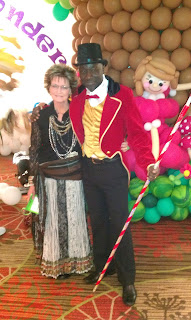 |
| Tope with Norma Roberts |

How do start the designing process for a party such as this Tope?
"The design process is usually the more interesting aspect for me...I approach room design (regardless of how big it is) like it's a big centrepiece design. Then I will treat each component like they are centrepieces in their own rights. It's always back to design basics for me. The elements and principles of design are my anchor, so using space, colour, line, form etc. and how these come together in unity, harmony, rhythm, proportion to each other to define the final whole of whatever project I work on. I think taking the time to understand these fundamentals of design, and the application is what makes the difference between a decorator and a designer in any art form.Once I had submitted my drawings, I decided I was going to enjoy the journey/process this time around".
Detailed sketches of specific decor elements fitting the circus theme for each of these areas:
"I overworked myself during the preparation and I couldn't enjoy the party 10 years ago, ( I didn't even bring my own costume to Chicago.) This time I paced myself better and I was more organised.
I focused on my strengths and I chose to delegate a lot more than I did 10 years ago.
I arrived in Dallas early to start work on the Monday. I took breaks when I needed, and I had a fantastic team around me and a good project manager."
Tope selected the Polka Dots & Dots Bubble (15608) to create his colour palette for the party!
| more Monkey's! |
| Tope's awesome team! |
I asked some of the newly qualified CBA delegates from the World Balloon Convention to tell me some of their WBC highlights, as you can see the party featured very highly!
"The costume party. The decor by Tope was fun and rich and it was great to see everyone parting and just having a good time"! - Malachi Robinson CBA
"The Gala and Circus decorating was amazing"! - Tracy Hawes CBA
"The WOW Factor of all the Decor, I have only seen in magazines and online - it was so much more impressive and the techniques were easier to comprehend". - Amanda Pierce CBA
"Circus theme party and Gala dinner where everyone dressed up for the occasion"! - Annabelle Claire Tan CBA
"Helping to build the decor for the special events". - Elaine Holmes CBA
"Blown away by the Circus theme, absolutely fantastic"! - John Brew CBA
 |
| The awesome Clown entrance arches!!! |
| The 'Big Top' and Clown Head... |
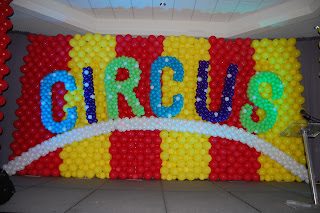 |
| 'Circus' Stage Wall |
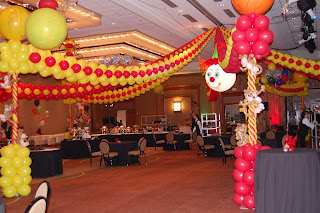 |
| Looking across the room |
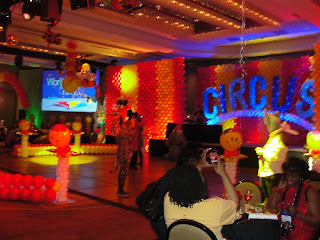 |
| Room decor with the stage 'Circus' wall and some very cool lighting! |
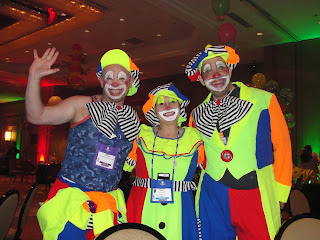 |
| Fantastic costumes! |
 |
| Guess who... this IS Ted & Betty Vlamis... looking great! |
I would like to take this opportunity to congratulate Tope Abulude and his amazing team, the decor and party was truly awesome. I would also like to thank Tope for sharing such great information, his early plans & details on how he worked to create yet another truly memorable event!
 |
| Tope Abulude CBA, Balloon Inspirations, London, UK |
"I would like to thank contributing artists Cam Woody, Keith Stirman, Dom Cassidy, Connie Iden-Mounds, Dmitriy Tishenko, Andrey Osokin and David Debustos, the WBC staff and Volunteers (too long a list to name) and it was a pleasure to work with Nick Otis (and his team) and LaDonna Belcher".
Well, I am off to 'BACI'- Balloon Arts Convention Italy, where I will be making a large sculpture with 'Team Bowler'! I am hoping that they will have 'livecam' during the sculpture build again this year (Friday 20th April & Saturday 21st April), if they have, I'll make sure that I post it on the Qualatex Facebook Group page!
See you soon with some great new blogs!
Happy ballooning!
Sue
www.suebowler.com























